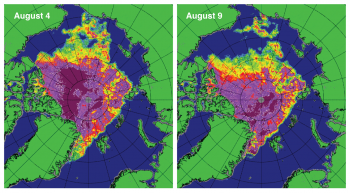| Reply to Thread New Thread |
|
|
#41 |
|
|
|
|
|
|
|
#42 |
|
|
. |
|
|
|
|
#43 |
|
|
|
|
|
|
|
#45 |
|
|
|
|
|
|
|
#46 |
|
|
|
|
|
|
|
#49 |
|
|
Hah!
Take that, polar bears! ***"That" being all of the above. Of course though, one years data doesn't mean anything... Even if it's a preponderance of data closely correlated with other independent data which all points to the same thing. Sometimes I wish I could have the same kind of denialist mindset demonstrated by "climat skeptics", and be simultaneously aware of my cognitive dissonance, just so I could see what it's like to be that way. It seems to me it's been a while since the latest IPPC report. When is the next one due, and what irrelevent yoles do you think we wiil hé able to pick ni it? |
|
|
|
|
#50 |
|
|
It seems to me it's been a while since the latest IPPC report. When is the next one due, and what irrelevent yoles do you think we wiil hé able to pick ni it? Hopefully they will have done a better job of keeping the dross out this time.
BTW, with regard to wattsupwiththat's reference to the MASIE data: In the three days after he published that piece, the MASIE estimate dropped 613761 sq km, better than 200000 sq km per day. The most recent estimate from the MASIE set (for 1 Sep) is 4027491 sq km, which surprise surprise is indeed the all time record for the MASIE dataset. |
|
|
|
|
#51 |
|
|
|
|
|
|
|
#53 |
|
|
|
|
|
|
|
#54 |
|
|
|
|
|
|
|
#57 |
|
|
|
|
|
|
|
#58 |
|
|
Seems this thread is all about labelling the Arctic circumnavigation phenomenon, & the new Arctic sea ice minimum (satellite era only) the result of anthropogenically forced climate change. It is neither evidence for this, nor, evidence to support the hypothesis of strongly positive feedback to a forcing.
The 'new minimum' sea ice extent is the result of weather, nothing more. The weather being the August Arctic storm, the strongest of its kind in 34 years, & at a time of the years when the storms effect would have the greatest impact on sea ice extent.  An unusually strong storm formed off the coast of Alaska on August 5 and tracked into the center of the Arctic Ocean, where it slowly dissipated over the next several days. The center of the storm at that date was located in the middle of the Arctic Ocean. The storm had an unusually low central pressure area. Paul A. Newman, chief scientist for Atmospheric Sciences at NASA's Goddard Space Flight , estimates that there have only been about eight storms of similar strength during the month of August in the last 34 years of satellite records. “It’s an uncommon event, especially because it’s occurring in the summer. Polar lows are more usual in the winter,” Newman said. Arctic storms such as this one can have a large impact on the sea ice, causing it to melt rapidly through many mechanisms, such as tearing off large swaths of ice and pushing them to warmer sites, churning the ice and making it slushier, or lifting warmer waters from the depths of the Arctic Ocean. “It seems that this storm has detached a large chunk of ice from the main sea ice pack. This could lead to a more serious decay of the summertime ice cover than would have been the case otherwise, even perhaps leading to a new Arctic sea ice minimum,” said Claire Parkinson, a climate scientist with NASA Goddard. |
|
|
|
|
#59 |
|
|
These three data sets -
Nansen Environmental and Remote Sensing Center (NERSC) – Arctic Regional Ocean Observing System http://arctic-roos.org/observations/..._ext_small.png Danish Meteorological Institute http://ocean.dmi.dk/arctic/plots/ice...er_current.png Japan Aerospace Exploration Agency (JAXA) – International Arctic Research Center (IARC) http://www.ijis.iarc.uaf.edu/seaice/...e_Extent_L.png clearly show that the sea ice extent was tracking above the 2007 minimum prior to the August storm. -- -- -- -- From NCAR & UCAR https://www2.ucar.edu/atmosnews/opin...arctic-cyclone Just how unusual was this cyclone? It’s surprisingly hard to get a precise answer, since Arctic Ocean weather is so difficult to observe. For decades, surface pressure was measured only on a few Arctic islands, at a few land-based stations ringing the ocean, and with an array of floating buoys. Satellite cloud photos also helped estimate surface pressures, but routine, high-quality satellite monitoring did not begin until 1979. Nevertheless, it’s clear this storm was“truly remarkable,” says Ian Simmonds (University of Melbourne).He and Mark Drinkwater (European Space Agency) produced a paper in 2007 for the World Meteorological Organization entitled “A ferocious and extreme Arctic storm in a time of decreasing sea ice” (PDF ). Their study analyzed a low that spun across the Arctic in August 2006, with a central surface pressure that dipped to 984 hectopascals—on par with a major U.S. winter storm. This year’s Great Arctic Cyclone leaves that“ferocious” storm in the dust, with a central pressure that bottomed out at 963hPa. No other summer storms—and only a tiny number of winter storms—have beenthat intense across the Arctic since 1979, according to Simmonds, who led astudy of Arctic cyclones published in 2008 in the Journalof Climate. |
|
|
|
|
#60 |
|
|
.
.  This massive storm in the Arctic allowed a shift in Arctic sea ice concentrations across the region. Large reductions in the extent and concentration of sea ice can be seen in the left-hand side of each image above, where the Bering Sea empties into the Arctic Ocean. Strong polar lows in the Arctic can tear off large swaths of ice and push them to warmer locations. These storms can also mix up the ice and make it become slushy and upwell warmer waters to the surface. On average, Arctic cyclones last about 40 hours; as of August 9, 2012, this storm had lasted more than five days. |
|
|
| Reply to Thread New Thread |
«
Previous Thread
|
Next Thread
»
| Currently Active Users Viewing This Thread: 1 (0 members and 1 guests) | |
|
|




 Linear Mode
Linear Mode


